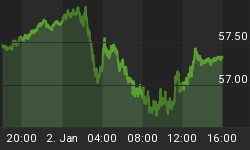The following is commentary that originally appeared at Treasure Chests for the benefit of subscribers on Wednesday, November 17th, 2010.
It's no secret Ron Paul is expected to chair the Monetary Policy Subcommittee starting next year, and that he intends to properly audit the Fed and US gold reserves as initial steps in attempting to return America to some degree of fiscal discipline. Because there can be little doubt an expanding bureaucracy has hit the limit in terms of what the system can take, which is why you will never see the Fed voluntarily abandon QE2. And this is especially true because of the deflation (of everything from currency to population) peak oil guarantees, not to mention other unintended consequences increasing fiscal restraint would bring. The bottom line here is the bureaucracy will continue to monetize the debt on an increasing basis until the system implodes on itself, which will be the result of uncontrollable rising interest rates and gold prices, which according to Mark Lundeen should be considerably higher.
Impossible? It could be argued it's already happening, where this week for example, despite a generous POMO schedule this week bonds are falling anyway due to the reporting of uncontrollable price increases and increasing sovereign credit concerns that will surely not disappear anytime soon. So please, don't be confused by all the propaganda, no matter what the bureaucracy leaders tell you, money printing and monetization practices will remain relentless, although we may get a taste of austerity not many will like as we move into next summer as Mr. Paul does his damdest to fix the world, which will of course prove dangerous to our fiat currency economies at the time. Crashing stock and bond markets in North America will certainly make 'austerity' a four letter word as process unfolds, however there is no guarantee another bloated fiat currency system would emerge on the other side of an unwinding, making 'debt' an actual four letter word people (creditors) will undoubtedly be paying closer attention to under such circumstances.
In the meantime however, prices have not been falling to support the bureaucracy's phony inflation reports, so with the retail trade 'all in' (to stocks) as reflected in US index open interest put / call ratios, explained here last week, it's time for a short-term correction. At least that's what it better be, or the equity complex will be in real trouble a bit early from a cyclical perspective, where we are anticipating a terminal high in stocks during the first quarter of next year, as per the count and patterning presented in the charts below. First we have the long-term Super-Cycle Grid that shows although more room exists for gains, we are entering a cyclical (time-line) turning point. (See Figure 1)
Figure 1
The second chart zooms in on the lower degree waves to look for clues in the most probable count, etc., displayed below, which in my view would confirm the rising and high probability of an important top being put in place sometime in the first quarter of next year, or shortly afterwards. What we have unfolding here is a typical zigzag, which is a five-wave sequence separated by a corrective three-wave sequence, followed by another five-wave sequence, which you can see has yet to unfold. I have studied the count here for some time and see no other alternative; especially given the big picture where we are expecting a test of the 2009 lows eventually (the larger degree a - b - c sequence in red), so none will be provided (See Figure 2)
Figure 2
And as you may know, I also expect the same patterning and timing from gold (and silver) running into next year based on historical precedent (the last big top was in February), where although the cycle might run longer this time because of the higher degree (Grand Super-Cycle?) of the present move, still, some degree of top can be expected at this time, and I can tell you why. Why then? Because our buddy, Ron Paul, will likely be successful in getting enough people who matter pushed over into the Fed audit / austerity camp by then, which will be bad news for the aggregate bubble economy. And again, even if he is ultimately not successful in this regard, he will be making enough noise when he is first appointed chair to get people taking him seriously, which at a minimum will push prudent traders into defensive postures, which means lightening up on equities, precious metals, and anything else associated with the inflation trade.
Remember folks, you read this here first.
Good investing all.
















